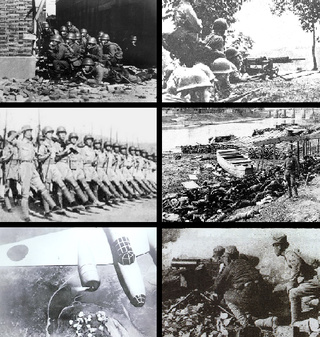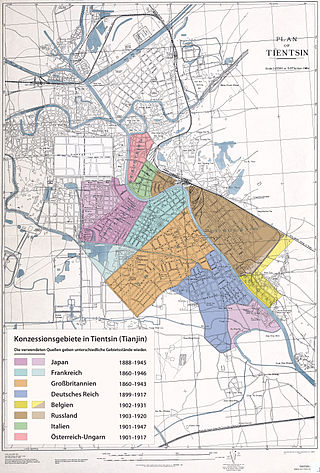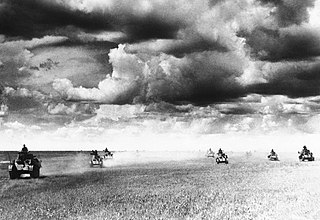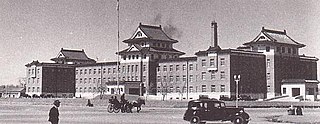
The Second Sino-Japanese War (1937–1945) or War of Resistance was a military conflict that was primarily waged between the Republic of China and the Empire of Japan. The war made up the Chinese theater of the wider Pacific Theater of the Second World War. The beginning of the war is conventionally dated to the Marco Polo Bridge Incident on 7 July 1937, when a dispute between Japanese and Chinese troops in Peking escalated into a full-scale invasion. Some Chinese historians believe that the Japanese invasion of Manchuria on 18 September 1931 marks the start of the war. This full-scale war between the Chinese and the Empire of Japan is often regarded as the beginning of World War II in Asia.

The Pact of Steel, formally known as the Pact of Friendship and Alliance between Germany and Italy, was a military and political alliance between Italy and Germany.

The Mukden Incident, or Manchurian Incident, known in Chinese as the 9.18 Incident (九・一八), was a false flag event staged by Japanese military personnel as a pretext for the 1931 Japanese invasion of Manchuria.

The Battle of Shanghai was the first of the twenty-two major engagements fought between the National Revolutionary Army (NRA) of the Republic of China (ROC) and the Imperial Japanese Army (IJA) of the Empire of Japan at the beginning of the Second Sino-Japanese War. It lasted from August 13, 1937, to November 26, 1937, and was one of the largest and bloodiest battles of the entire war, later described as "Stalingrad of the China", and is often regarded as the battle where World War II started. After over three months of extensive fighting on land, in the air and at sea, the battle concluded with a victory for Japan.
This article is concerned with the events that preceded World War II in Asia.

This timeline of events preceding World War II covers the events of the interwar period (1918–1939) after World War I that affected or led to World War II.

The January 28 incident or Shanghai incident was a conflict between the Republic of China and the Empire of Japan. It took place in the Shanghai International Settlement which was under international control. Japanese army officers, defying higher authorities, had provoked anti-Japanese demonstrations in the International Settlement following the Japanese invasion of Manchuria. The Japanese government sent a sect of militant ultranationalist Japanese Buddhist priests belonging to the Nichiren sect to Shanghai. The monks shouted anti-Chinese, pro-Japanese nationalist slogans in Shanghai, promoting Japanese rule over East Asia. In response, a Chinese mob formed killing one monk and injuring two. In response, the Japanese in Shanghai rioted and burned down a factory, killing two Chinese. Heavy fighting broke out, and China appealed with no success to the League of Nations. A truce was finally reached on May 5, calling for Japanese military withdrawal, and an end to Chinese boycotts of Japanese products.

Japanese militarism refers to the ideology in the Empire of Japan which advocates the belief that militarism should dominate the political and social life of the nation, and the belief that the strength of the military is equal to the strength of a nation.
The political situation in Japan (1914–44) dealt with the realities of the two World Wars and their effect on Japanese national policy.

The foreign concessions in Tianjin were concession territories ceded by Qing China to a number of European countries, the United States and Japan within the city of Tianjin. There were altogether nine foreign concessions in old Tianjin on the eve of World War II. These concessions also contributed to the rapid development of Tianjin from the early to mid-20th century. The first foreign concessions in Tianjin were granted in 1860. By 1943, all the foreign concessions, except the Japanese concession, had ceased to exist de facto.

The Wanpaoshan Incident was a minor dispute between Chinese and Korean farmers which occurred on 1 July 1931. Through a series of false reports, the issue was highly sensationalized in the Imperial Japanese and Korean press, and used for considerable propaganda effect to increase anti-Chinese sentiment in the Empire of Japan prior to the Japanese invasion of Manchuria.

The Empire of Japan's Kwantung Army invaded Manchuria on 18 September 1931, immediately following the Mukden Incident. At the war's end in February 1932, the Japanese established the puppet state of Manchukuo. Their occupation lasted until the success of the Soviet Union and Mongolia with the Manchurian Strategic Offensive Operation in mid-August 1945, towards the end of the Second World War.

The Soviet–Japanese border conflicts, also known as the Soviet-Japanese Border War or the First Soviet-Japanese War of (1932-1939), was a series of minor and major conflicts fought between the Soviet Union, Mongolia and Japan in Northeast Asia from 1932 to 1939. It is the first Soviet-Japanese War.

The Tientsin incident of 1931 was the operation planned by the Kwantung Army of the Empire of Japan to place Puyi on the throne of the Japanese-controlled Manchuria. The plan, orchestrated by Colonel Kenji Doihara and Colonel Itagaki Seishiro was successful, and Puyi became the Chief Executive of Manchukuo the following year. Puyi was subsequently enthroned as the Kangde Emperor in 1934.

The Pacification of Manchukuo was a Japanese counterinsurgency campaign to suppress any armed resistance to the newly established puppet state of Manchukuo from various anti-Japanese volunteer armies in occupied Manchuria and later the Communist Northeast Anti-Japanese United Army. The operations were carried out by the Imperial Japanese Kwantung Army and the collaborationist forces of the Manchukuo government from March 1932 until 1942, and resulted in a Japanese victory.

Yoshitsugu Tatekawa was a lieutenant-general in the Imperial Japanese Army in World War II. He played an important role in the Mukden Incident in 1931 and as Japanese ambassador to the Soviet Union he negotiated the Soviet–Japanese Neutrality Pact in 1941.

The Marco Polo Bridge Incident, also known as the Lugou Bridge Incident or the July 7 Incident, was a July 1937 battle between China's National Revolutionary Army and the Imperial Japanese Army.

The Kwantung Army was a general army of the Imperial Japanese Army from 1919 to 1945.